Located at the southernmost part of Taipei County, the town of Yingko derives its name from a parrot-shaped rock standing on a mountain slope at the northern edge of the town. Its population is around 80,000 and it is home to a number of ceramics enterprises, large and small, with a rather dense concentration of ceramics stores and Taiwan's only large-scale ceramics museum -- the Taipei County Yingko Ceramics Museum (
Yingko kilns were established by Wu An (
According to Renny Lin (
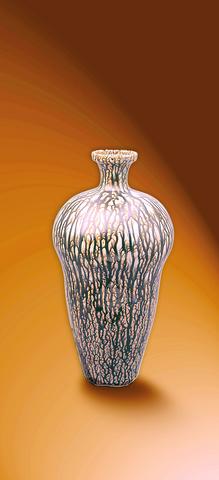
PHOTO: YINGKO CERAMIC MUSEUM
Among all varieties of ceramic works, crystal glaze (結晶釉) stands out as one of the most eye-catching artistic items in Yingko. It possesses a very bright and shiny glazed appearance, mostly with varied flower patterns. These types of crystalline art pieces were presented at many international exhibits in early 1990s, when the skills require to produce it matured, and was acclaimed by international ceramists as "the glory of Taiwan," owing to its brilliant and compelling colors.
Crystal glaze has many special effects. The position and size of the flowers on each artwork can never be the same. There is no way to control the pattern, which makes the result of firing unpredictable and, thus, very exciting. Sun Chao (
All work with crystal glaze requires high-firing temperatures of 1,200C or more and lengthy reaction cycles. One trade practice is to import a special kind of clay, porcelain No. 26, from Japan and mix it with local clay to formulate high-fired white wares. Another key to every successful piece lies in proper temperature control. First the kiln reaches the target temperature and remains there for a required period of time. Then the artist allows the heat to drop below 1,200?C and the glaze nucleates and crystals soon emerge. The temperature at which crystalline materials grow is around 1,180?C and, as heat drops down to between 1,100?C and 1,050?C, crystalline materials gradually complete their growth process. These materials then pop off from one center point outward to form shapes like spherulites or dendrites. After cooling down, the glaze develops crystals of various sizes, shapes and colors.
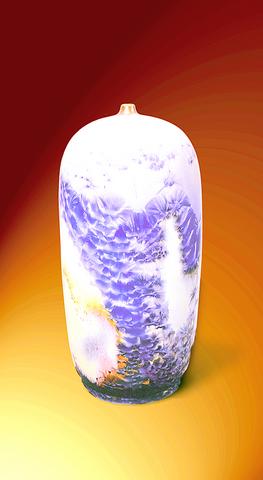
PHOTO: YINGKO CERAMIC MUSEUM
The special effects produced using crystal glazes come from chemical compounds such as zinc, iron, copper, cobalt, manganese, titanium and other crystal agents added to a base glaze. Lin San-chiang (林三江) of Han-Sheng Pottery (漢聲窯業) explains: " It [crystal glaze] belongs to a particular type of glazing with high fluidity and a free-flowering result. Each work of art demands time-consuming repetition of process and highly stable temperatures. We maintain our kiln's temperature at 1,260?C for a period of time and it takes about 40 hours to complete the firing process and the piece to return to room temperature."
The crystalline glaze technique was first developed in the mid-19th century at the Sevres Porcelain Factory, in France. In 1904, American glaze artist Adelaide Alsop Robineau continued to fire the first crystalline glaze work in Syracuse, New York, which led to the establishment of the Everson Museum of Art and its large collection of her glazed artworks. From then on, the secret of creating crystalline glaze was made public by many British and American artists.
Taiwanese artist Sun Chao started to apply crystal glaze to traditional high-fired white wares in the 1980s and made marvelous breakthroughs at his own pottery studio in Sanchih, Taipei County. Owing to his personal effort, his artworks inspired quite a number of artists in Taiwan -- and Yingko in particular.
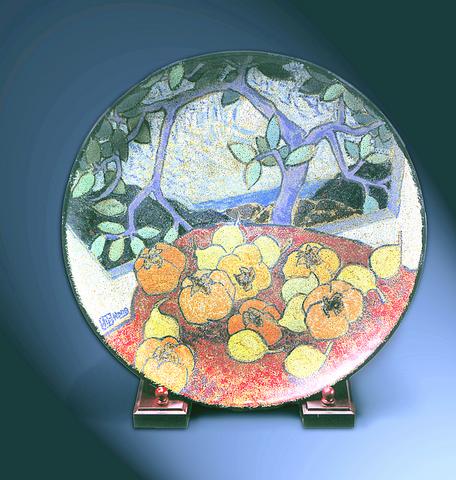
PHOTO: YINGKO CERAMIC MUSEUM
In the early 1990s, through the use of computer software for gas-fired kilns, talented ceramists in Yingko perfected mass-produced methods for firing crystal glazes and brought down the price considerably for local art collectors.
Yingko's ceramists are reputed for producing exquisitely large crystals in zinc crystal glaze. Wu Chine Fong (吳進風), director of the Ceramics Museum, proudly pointed out to the Taipei Times that "crystals in the earlier period used to be monochrome. With the techniques and equipment improved, crystal glazes distinguish themselves not only with multi-colored crystals, but also with various patterned decorations and compositions.
"Created with broad variations in lines, colors, textures and patterns, crystal glazes have helped Yingko [become] the ceramics kingdom of Taiwan and even to achieve a standard of ceramic art creation that far exceeds the international level."
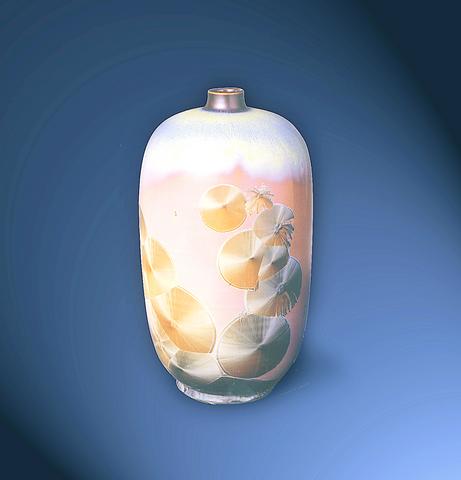
PHOTO: YINGKO CERAMIC MUSEUM
The latest trend in the Yingko ceramic world is an attempt to combine crystal and non-crystal glazes in pursuit of a new ceramic style. For example, a combination of one of the overglaze (釉上彩) techniques called chin-tsai (金彩), which applies liquid gold onto the porcelain, with crystal glaze, in recent years has produced pieces unmatched in their texture and patterns. It is this spirit of artistic innovation that keeps Yingko very much alive and exciting and helps local ceramics artists to continue to prosper.
Transportation:
By rail
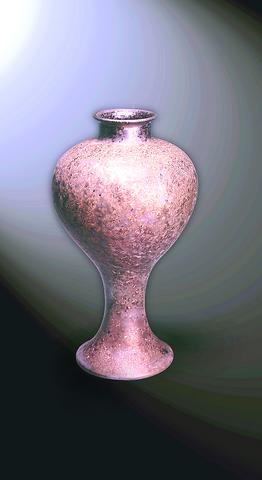
PHOTO: YINGKO CERAMIC MUSEUM
Take a train on the west-coast trunk railway and get off at Yingko Station
By bus
1. Take Taipei Bus 702 on the Taipei-Sanhsia line from Chunghua Rd. in Taipei and get off at Yingko.
2. Take blue Taipei Bus 19 from the HsinpuMRT station in Panchiao to Tingko.
3. Take a Taoyuan Bus Co. bus to Yingko from Fuhsing Rd. in front of the Toyyuan Railway Station.
By car
1. Via National Highway NO.3 (the Second Northern Freeway): Exit at the Sanying interchange to Yingko, cross Sanying Bridge and continue straight on to the Yingko Ceramics Museum.
2. Via National Highway NO.1 (the Sun Yat-sen Freeway): At the Taoyuan Airport interchange, coonect with National Expressway NO.2 and exit at the Danan interchange and proceed along Yingtao Highway to Yingko.

On April 26, The Lancet published a letter from two doctors at Taichung-based China Medical University Hospital (CMUH) warning that “Taiwan’s Health Care System is on the Brink of Collapse.” The authors said that “Years of policy inaction and mismanagement of resources have led to the National Health Insurance system operating under unsustainable conditions.” The pushback was immediate. Errors in the paper were quickly identified and publicized, to discredit the authors (the hospital apologized). CNA reported that CMUH said the letter described Taiwan in 2021 as having 62 nurses per 10,000 people, when the correct number was 78 nurses per 10,000

As we live longer, our risk of cognitive impairment is increasing. How can we delay the onset of symptoms? Do we have to give up every indulgence or can small changes make a difference? We asked neurologists for tips on how to keep our brains healthy for life. TAKE CARE OF YOUR HEALTH “All of the sensible things that apply to bodily health apply to brain health,” says Suzanne O’Sullivan, a consultant in neurology at the National Hospital for Neurology and Neurosurgery in London, and the author of The Age of Diagnosis. “When you’re 20, you can get away with absolute

May 5 to May 11 What started out as friction between Taiwanese students at Taichung First High School and a Japanese head cook escalated dramatically over the first two weeks of May 1927. It began on April 30 when the cook’s wife knew that lotus starch used in that night’s dinner had rat feces in it, but failed to inform staff until the meal was already prepared. The students believed that her silence was intentional, and filed a complaint. The school’s Japanese administrators sided with the cook’s family, dismissing the students as troublemakers and clamping down on their freedoms — with

As Donald Trump’s executive order in March led to the shuttering of Voice of America (VOA) — the global broadcaster whose roots date back to the fight against Nazi propaganda — he quickly attracted support from figures not used to aligning themselves with any US administration. Trump had ordered the US Agency for Global Media, the federal agency that funds VOA and other groups promoting independent journalism overseas, to be “eliminated to the maximum extent consistent with applicable law.” The decision suddenly halted programming in 49 languages to more than 425 million people. In Moscow, Margarita Simonyan, the hardline editor-in-chief of the